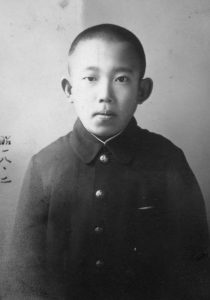My Life — Interview with Hiromu Morishita (1930-), A-bomb survivor and teacher, Part 3: Enrolled in Hiroshima First Middle School
Apr. 21, 2022
War embedded in daily lives
On December 8, 1941 (Japan time), the Pacific theater of World War II began with the Imperial Japanese Navy’s attack on Pearl Harbor in Hawaii. It was the winter of Mr. Morishita’s fifth-grade year in elementary school.
I remember my father's excited cry of “We did it!” as he listened to the news on the radio. It was around this time that I began to visit the Hiroshima Gokoku Shrine, located in the area of the former Hiroshima Municipal Baseball Stadium (in Hiroshima’s Naka Ward), every morning to pray for Japan’s victory in the war.
As I look back, the war had become deeply embedded in our daily lives by that time. When Nanjing fell, I took part in a parade with paper lanterns. At school, we were made to recite from memory the names of Japan’s succession of emperors, and model tanks were used in competitions at school athletic meets. We often sang war songs. My father and I believed Japan would win the war.
After graduating from Hakushima Elementary School, Mr. Morishita enrolled in Hiroshima First Middle School (present-day Kokutaiji High School, in the city’s Naka Ward).
We were strictly disciplined at school. We were afraid of the teachers. When we were late for school they used to hit us, or strike us on the head with the tip of a bamboo broomstick. Because I was smaller than the other students, I struggled to carry all my things while running to school every day. There was also an officer assigned to the school. The military training with wooden guns was so hard.
We became more and more engaged in volunteer labor. At first, our work mainly involved helping farmers harvest barley and improve drainage in rice and vegetable fields while we stayed at a temple in the Kabe area (in Hiroshima’s Asakita Ward). The work I always looked forward to was that involving the leveling of the ground at the Yoshijima Air Field (now part of Naka Ward) because we were given dumplings that appeared to have been made of grass and rice bran kneaded together. They weren’t any good, but at least my belly was full.
The food situation was bad, with the only food available being corn and sweet potatoes. One day, my mother said, “If our lives are this hard, Japan will surely lose the war.” I will never forget that. I spoke back to her with an air of arrogance. “Mother, you should never say such a thing,” I said.
Around the time Mr. Morishita became a third-grader at the school, students began working at Toyo Kogyo (present-day Mazda Motor Corporation) in Fuchu-cho, Hiroshima Prefecture.
The company held a welcome ceremony for us, which made us feel proud. We engaged in the work of making pistons and guns for fighter planes. However, we soon ran out of materials. In the summer of my third year, the students were divided into groups and took turns helping to demolish buildings in the city. We tied ropes to pillars and pulled them down, shouting “heave-ho!” On August 6, 1945, my group was assigned to the work of demolishing buildings for the creation of fire lanes.
(Originally published on April 21, 2022)








